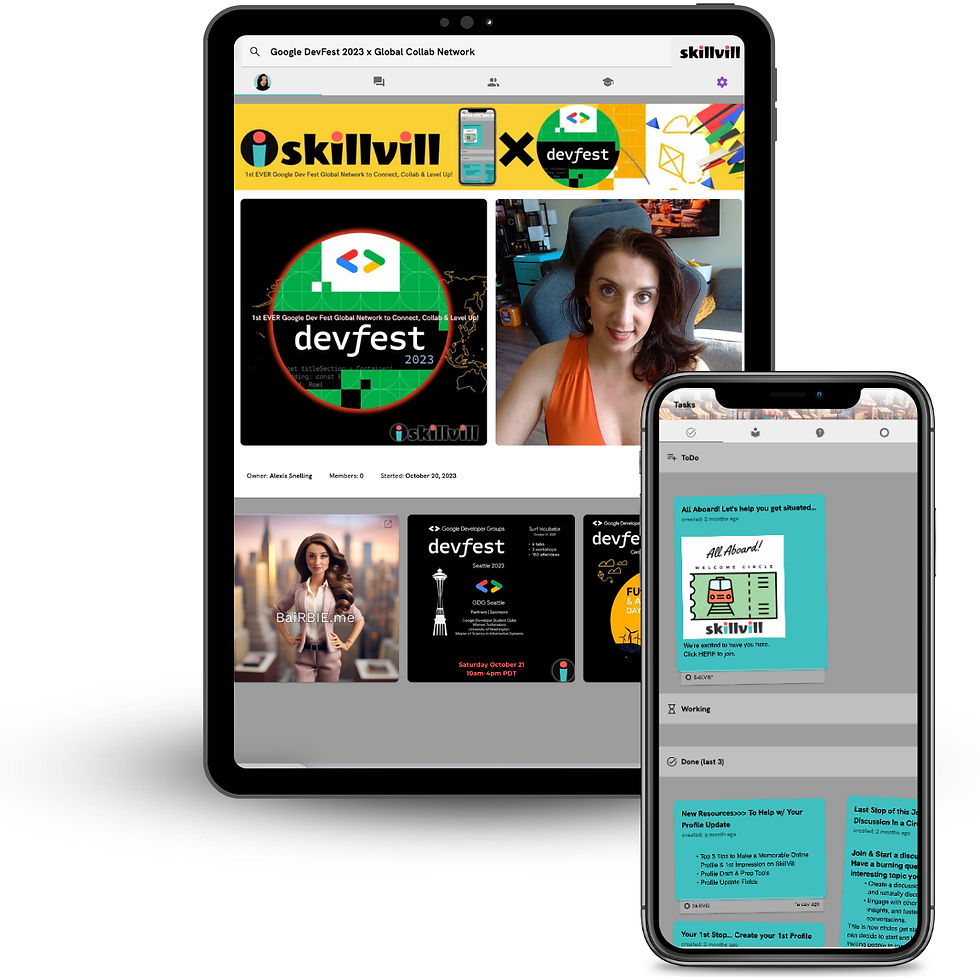Mighty Networks vs SkillVill
- Alexis Snelling
- Jul 30
- 4 min read
Updated: Oct 1
Mighty Networks is a powerful platform for building online communities, and it does a good job of fostering general connections, sharing content, and enabling general discussions. However, when compared to a "next-generation social network" specifically designed for actionable skills, peer-to-peer feedback, real-time spontaneous networks, and easy-to-use AI search questions, Mighty Networks has some inherent limitations.

Here's why a more traditional community network like Mighty Networks might not fully encourage this environment:
1. Structure and Design Philosophy:
Content-Centric vs. Skill/Action-Centric: Mighty Networks is largely designed around content (posts, articles, courses, events) and topics.2 While skills can be discussed and courses taken, the platform isn't inherently structured to track, validate, or actively foster the application and improvement of individual skills.
Curated vs. Organic/Spontaneous: Mighty Networks excels at building structured communities around shared interests or a creator's offerings. It's less designed for truly spontaneous, just-in-time connections based on a dynamic "skill need" that arises in the moment. The emphasis is on building a lasting community around a theme, not necessarily fluid, temporary project teams.
Community Management Focus: Mighty Networks provides robust tools for community hosts to manage content, members, and groups.3 While this is crucial for traditional communities, it's not the same as empowering users themselves to dynamically form networks based on immediate skill needs.
2. Limitations in Skill-Specific Features:
Basic Skill Profiles: While users can list skills, Mighty Networks typically doesn't offer sophisticated skill taxonomies, proficiency levels, or portfolio features designed to showcase actionable skill demonstration (e.g., embedding code, project work with version control, detailed case studies).
Limited Structured Feedback: While comments and discussions are central, Mighty Networks isn't built for structured, granular, and context-specific peer feedback on specific skill outputs. It lacks dedicated rubrics, time-stamped comments on specific work, or systems to track feedback history related to skill development.
Lack of Built-in Skill Challenges/Gigs: It doesn't inherently support the creation and tracking of micro-projects or "gigs" designed for skill application and peer review, which are crucial for actionable skill development.
3. AI Integration (Past vs. Future Focus):
AI for Content/Discovery vs. Dynamic Matching: While Mighty Networks has started incorporating AI (e.g., AI Cohost for content generation, "Show Similarities" for basic connections), its primary AI use often leans towards making content creation easier or suggesting static connections based on profile data.
Lack of Advanced AI Search for Actionable Needs: The "easy-to-use AI search questions" you envision go beyond simple keyword searches. They imply an AI that can understand complex natural language queries about problems to solve or skills to acquire/apply, and then dynamically connect users with the right people, resources, or spontaneous groups in real-time. Mighty Networks' search is more akin to content and member search within a predefined structure.
No Proactive Skill Gap Analysis: It generally doesn't use AI to analyze a user's activity and feedback to proactively identify skill gaps or recommend personalized learning paths based on their actual performance.
4. Real-Time Spontaneous Networking Challenges:
Designed for Asynchronous/Event-Based: Mighty Networks is excellent for live events, discussions, and course delivery.4 However, its core design isn't optimized for the spontaneous, ad-hoc formation of temporary teams around immediate, often unpredictable, needs.
Limited "Just-in-Time" Connection Logic: The "real-time spontaneous networks based on easy to use AI search questions" imply an instant matchmaking capability that triggers when a user has a specific, immediate need ("I'm stuck on this Python problem right now, who can help me for 15 minutes?"). Mighty Networks' strength is in ongoing relationships within defined groups, not necessarily these fleeting, problem-solving connections.
5. Monetization and Business Model:
Creator/Course-Driven Monetization: Mighty Networks is heavily geared towards creators selling courses, memberships, and events.5 Its feature set supports this business model very well. A skill-centric network, however, might have different monetization avenues, such as micro-gigs, validated skill assessments, or paid peer mentorship, which aren't Mighty Networks' primary focus.
In essence, Mighty Networks is a fantastic "community hub" that enables creators to build and manage engaging groups around specific themes. However, the vision of a "next-generation social network" for actionable skills, peer-to-peer feedback, and real-time spontaneous networking requires a more dynamic, performance-oriented, and AI-driven infrastructure that goes beyond traditional community management tools. It's about shifting from primarily content consumption and discussion to skill application, validation, and real-time collaborative problem-solving.
Be Proactive vs. Reactive:
5 key steps to direct your program to the forward-thinking, proactive approach from the slower, less effective "reactionary old way". This shift is particularly crucial for market leaders and first movers who cannot afford to miss opportunities or lack context in today's fast-paced environment.
The future of digital communities is in smart, adaptable networks that prioritize user value and real-time collaboration. This shift represents a compelling investment thesis in technologies that deliver on the promise of truly connected and efficient digital ecosystems.
You're invited to ... Stop by any week to our FREE Skills-Based Social Net-Worth-ing online meet-up HERE: https://luma.com/redefinepossible
Join our SkillVill WAITLIST
Help us build a skills based social network together! We need to show the community is ready for launch. You can make a difference right now by joining the WAITLIST and hear when we launch to our 1st Skills-Based Social Channel together
Learn how to move your community or host your own channel for your neXt event, workshop, program or peer collab!




Comments